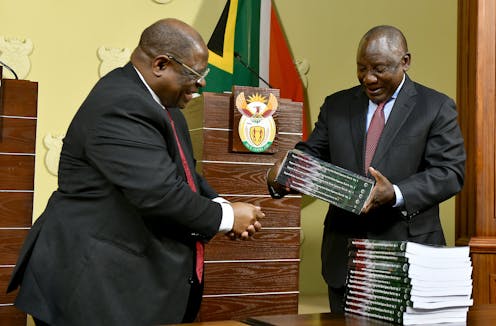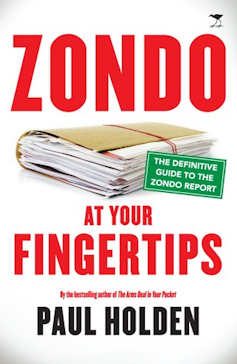
Anti-corruption activist Paul Holden has done South Africa a great favour by summarising the work of the judicial commission that probed massive corruption under former president Jacob Zuma. No one except academics will read the commission’s 4,750 page report, but many will read Holden’s book, Zondo at your Fingertips.
Holden is a former director of investigations at Corruption Watch, the South African corruption watchdog. He has worked with the investigative organisations Shadow World and Open Secrets for many years. He seeks to expose how corrupt individuals, aided by auditors and banks, not only looted the state but came to control it and pervert it into a kleptocracy.
The author, who has also lived in the UK, tells us that the Zondo commission was globally unique:
There are only a handful of examples of any state or quasi-judicial inquiry being given the task and resources to delve so deeply into the corruption of the ruling party … something like the scale, importance and independence of the Zondo Commission could never happen in the United Kingdom.
Holden has written a good and solid book, selecting and explaining the significant Zondo findings. It is useful for South Africans in getting a grasp of the commission’s report. Overall, this book is recommended for your bookshelf and every library.
If South Africans are lucky, the multi-volume report will be read through by prosecutors, who have the power to formulate charges and get the courts to issue warrants of arrest.

But the historical odds are stacked against this. The country has had over a dozen big commissions of inquiry. Not many people landed up in jail as a consequence.
How the story is told
Holden starts by telling us that the commission, headed by then deputy chief justice Raymond Zondo, heard 1,731,106 pages of documentary evidence, which it summarised in a transcript of 75,099 pages. The commission’s 19-volume report totals 4,750 pages. It heard 300 witnesses over 400 days of hearings, spread over four and a half years between 2018 and 2021.
Only the report of the Truth and Reconciliation Commission, which probed human rights abuses by both the apartheid regime and the liberation movement during the struggle for freedom in South Africa, has been comparable in length and scope. It sat from 1996 and submitted its final report in October 2003.
Read more: A democracy or a kleptocracy? How South Africa stacks up
The book is well structured in 10 parts. These include a chapter on the capture of state institutions such as the South African Revenue Service, the capture of state-owned enterprises such as South African Airways, the failures of the president, the African National Congress, and parliament, and a chapter on what money went where.
Commissions of inquiry
The most ambitious commission of inquiry set up in South Africa was the Truth and Reconciliation Commission. Set up in 1996 after the end of apartheid, it offered amnesty in exchange for information about atrocities.
No one who refused to apply for amnesty, or whose amnesty application was refused by the commission, was in fact prosecuted. A quarter of a century lapsed before the families of some detainees who’d been tortured to death found pro bono lawyers who instituted the reopening of inquests and other litigation – with zero support from the government.
The great majority of the recommendations of commissions of inquiry, such as the Farlam Commission into the massacre of striking miners and other killings at Marikana, North West province in 2012, remain unimplemented and ignored by the government. Sceptics argue that commissions of inquiry merely provide governments with a pretext to stall any remedial actions for years, until the politics of the front page has moved onto other issues.
Read more: South Africa has a new Chief Justice: an introduction to Raymond Zondo
Holden notes that Judge Zondo ordered the government to lay charges with the police against Dudu Myeni, former chair of South African Airways, for revealing the identity of a witness. But no arrest or prosecution has yet occurred. Likewise, the commission’s recommendations to the Legal Practice Council, to explore whether certain lawyers who enabled corruption should be struck off the roll, and to the auditors’ regulatory entity, to do the same with some auditors, have not yet resulted in action.
However, the author concludes, on the positive side, the Asset Forfeiture Unit, which is empowered to seize assets which are the proceeds of crime, successfully froze the Optimum coal mine to prevent it being sold on to cronies of the Guptas, the Indian family accused of orchestrating mass corruption in South Africa.
The Special Investigating Unit took up numerous cases against multinational companies to recoup state funds and got billions of rand refunded. The Investigative Directorate of the National Prosecuting Authority made numerous arrests; prosecutions are pending.
Recommendations
Holden notes that the Zondo Commission made a number of recommendations. Key among these are to professionalise all appointments to the boards of state-owned enterprises, and prevent cabinet ministers from appointing political cronies and other unqualified or compromised persons. The same applies to professionalising civil service, provincial, and municipal procurement officials.
Read more: Whistleblowers are key to fighting corruption in South Africa. It shouldn't be at their peril
Holden also summarises the commission’s enhanced proposed protection for whistle blowers, and to grant them compensation for losses they suffered. He notes that Zondo also flagged the deployment of party loyalists to key state positions as a violation of the constitution’s section 197 (3).
Keith Gottschalk is a member of the ANC, but writes this review in his professional capacity as a political scientist.
This article was originally published on The Conversation. Read the original article.







